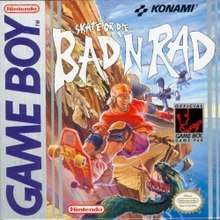Skate or Die: Bad 'N Rad
Skate or Die: Bad 'N Rad is a 2D action video game developed and published by Konami for the Game Boy. A part of the Skate or Die series created by Electronic Arts, the game was released in North America in September 1990, and in Europe in June 1991.
| Skate or Die: Bad 'N Rad | |
|---|---|
 North American box art | |
| Developer(s) | Konami |
| Publisher(s) | |
| Programmer(s) |
|
| Composer(s) | Hidehiro Funauchi |
| Series | Skate or Die |
| Platform(s) | Game Boy |
| Release | |
| Genre(s) | Action |
| Mode(s) | Single-player |
Gameplay

Skate or Die: Bad 'N Rad is a 2D action game, which contrasts to the original Skate or Die.[2] The player controls an unnamed skateboarder, whose quest is to rescue Miss Aerial from the antagonist, ElRad the Evil One.[1]:4–5 The game consists of seven stages in total, including the first four stages that are selectable by the player.[3] Each stage is played in one of two perspectives: a side-scrolling "horizontal mode" and a top-down "vertical mode",[1]:10–11 and has a time limit given to complete it. At the end of a horizontal stage, the player must confront one of the game's bosses, including Wart Monger and Bionic Lester.[1]:12–13
During gameplay, the player can move the skateboarder with the Game Boy's directional pad, while A and B buttons are used for jumping and crouching respectively.[1]:9 The skateboarder can also attack enemies by jumping on top of them with his skateboard.[1]:8 The player gains points by collecting aluminum cans and ice creams.[1]:16 At the start of the game, the player is given three lives.[2] An extra life is granted when the score reaches certain thresholds, or when the player obtains a 1-UP item during a stage. One life is lost when the skateboarder's health meter runs out, or if he falls into bottomless pits or traps. The game ends when all lives are lost.[1]:8
Development and release
Skate or Die: Bad 'N Rad was programmed by Toru Hagihara and Yukari Hayano, and the game's sounds were created by Hidehiro Funauchi and K. Noguchi.[4] The game was released in September 1990, in North America by Konami.[5] The European version was published by Palcom,[6] and was released in June 1991.[7]
Reception
| Reception | ||||||
|---|---|---|---|---|---|---|
| ||||||
In his review for AllGame, Jonathan Sutyak stated that the game can be difficult for players "to react quickly enough when something appears on the screen" due to its speed. Sutyak also praised the game's graphics, although he found it difficult to tell between what the player is skating on and what is the background.[2]
References
- Skate or Die: Bad 'N Rad Instruction Booklet. Konami. September 1990. DMG-SK-USA.
- Sutyak, Jonathan. "Skate or Die: Bad 'N Rad Review". AllGame. All Media Network. Archived from the original on November 15, 2014. Retrieved October 4, 2015.
- "Game Boy – Skate or Die: Bad 'N Rad". Nintendo Power. No. 16. Nintendo of America. September–October 1990. p. 56.
- Konami (September 1990). Skate or Die: Bad 'N Rad (Game Boy). Scene: Staff Credits. Level/area: Stage 7.
- "Game Boy (original) Games". Nintendo of America. Archived from the original (PDF) on October 1, 2015. Retrieved October 1, 2015.
- "Palcom Company Profile". GameSpy. Ziff Davis. Archived from the original on October 30, 2005. Retrieved October 1, 2015.
- "Skate or Die: Bad 'N Rad Game Editions". IGN. Ziff Davis. Archived from the original on October 1, 2015. Retrieved October 1, 2015.